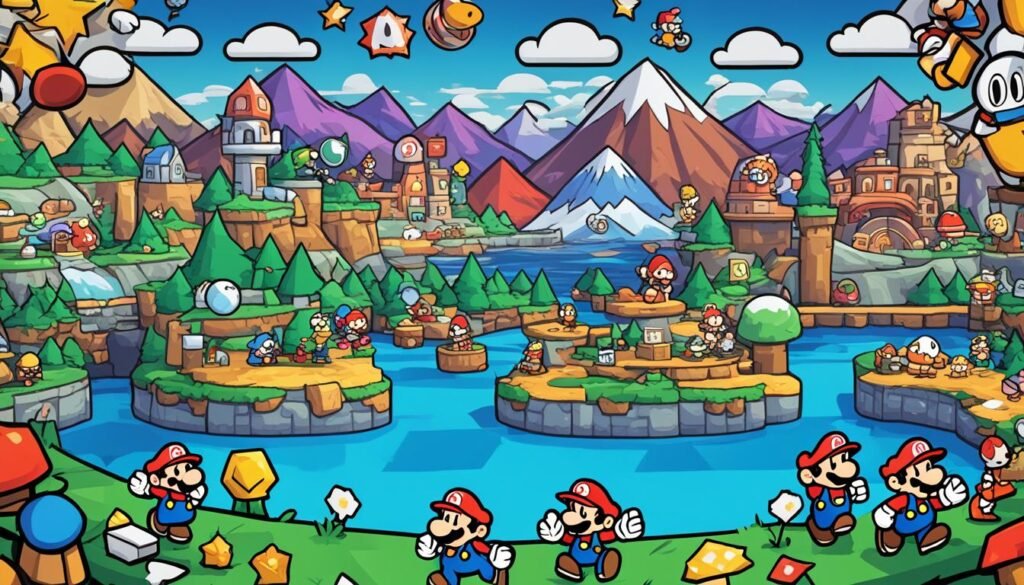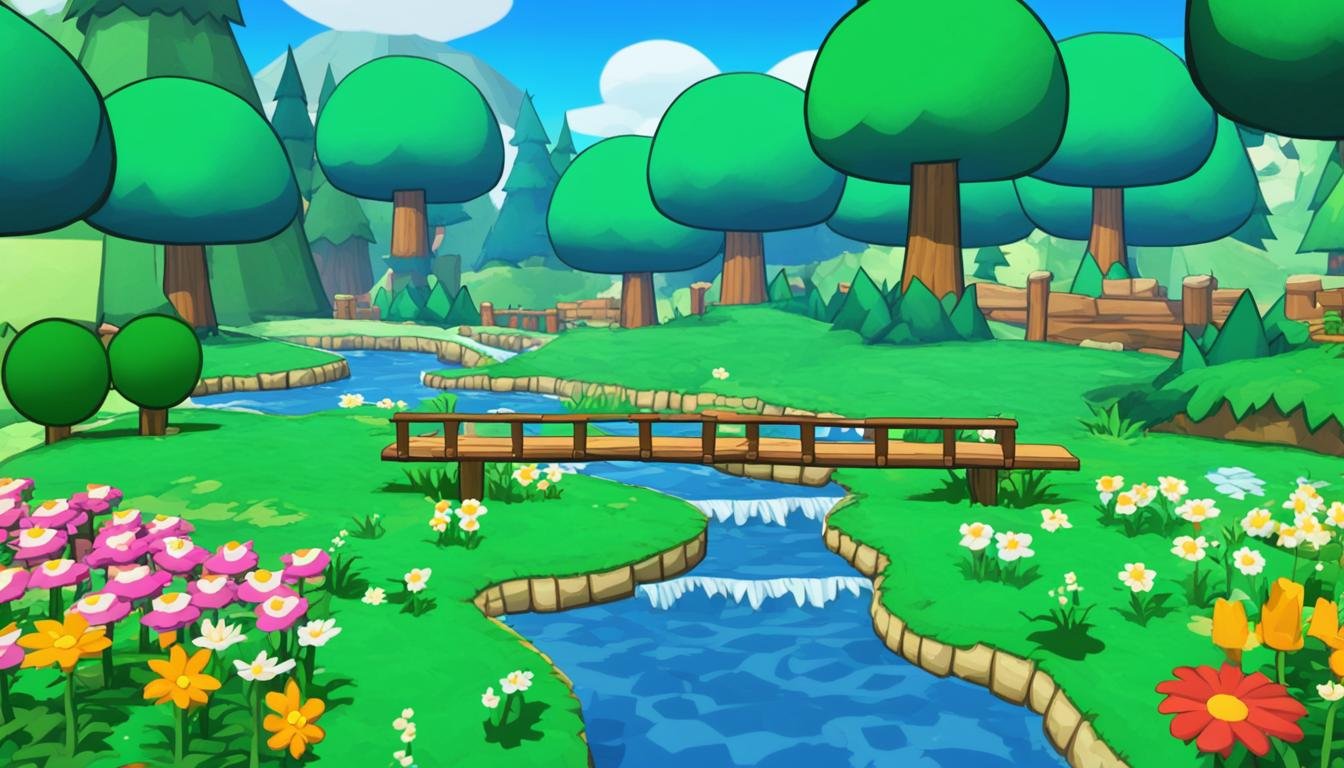Discovering a game that keeps us coming back is like finding gold. “Paper Mario: The Thousand-Year Door” is that gem for me. For the last 20 years, I’ve been pulled into its delightful world, fun gameplay, and rich story.
It came out in 2004 for the GameCube and was an instant hit. Players loved its turn-based fights, clever puzzles, and the chance to team up with allies. This mix made it a standout among Mario’s adventures.
The game is set in Rogueport, a lively land where Mario hunts for powerful Crystal Stars. These stars are linked to an ancient evil. As Mario journeys through places like Mt. Rugged and Twilight Town, each stop offers new fun and tests.
Chapter Six is a highlight, set in Flower Fields. The area is cleverly designed, spreading exploration across six paths. This part really draws players into its beautiful and challenging design.
However, the game isn’t perfect. Some players find the need for backtracking a bit much, especially in Chapter Three. Moving back and forth between some locations can be a bit dull.
Chapter Seven also includes a lot of revisiting past spots. This can be fun at first but may get tiresome.
Luckily, there’s good news. A remake of “Paper Mario: The Thousand-Year Door” is coming to the Nintendo Switch on May 23, 2024. This new version aims to fix old issues. Improvements like a fast travel system could make a big difference.
Overall, “Paper Mario: The Thousand-Year Door” remains a treasured RPG. Its world, fun challenges, and thrilling tale still win over fans. The remake’s updates could bring a fresh and smoother experience.
Key Takeaways:
- “Paper Mario: The Thousand-Year Door” is a beloved Mario RPG game for the Nintendo GameCube.
- The game features engaging gameplay, turn-based battles, and puzzle-platforming challenges.
- Players embark on a quest to collect seven Crystal Stars and uncover the ancient evil sealed beneath Rogueport.
- Backtracking is a notable flaw in the game, especially in Chapters Three and Seven.
- The upcoming remake of the game aims to address gameplay flaws and make improvements.
Welcome to Rogueport!
Prepare to enter Paper Mario: The Thousand-Year Door. You’ll land in Rogueport, famed for its zany characters and hidden dangers. But be ready, mysteries and adventures await you.
Your tale kicks off with a twist. Princess Peach has vanished, tracing a treacherous path in search of a legendary trove. As Mario, the task is yours to save her.
Legend speaks of the Crystal Stars. These powerful objects are spread far and wide. They guard the path to the Thousand-Year Door, behind which a great secret rests.
With your team, you aim to find the Crystal Stars. They’ll open the door and lead you to the Princess. Stay alert, though. Rogueport’s shadows hide many foes.
This town proves dangerous, with enemies from harmless Goombas to powerful ancient evils. It’s a test of your courage and cleverness.
| Enemy | HP | ATK | DEF |
|---|---|---|---|
| Goomba | 2 | 1 | 0 |
| Paragoomba | 2 | 1 | 0 |
| Spiky Goomba | 2 | 2 | 0 |
| Spinia | 3 | 1 | 0 |
| Spania | 3 | 1 | 0 |
| Blooper (Tentacles) | 12 (3) | 1 | 0 |
In your travels, you’ll face various Goomba types. Each needs smart moves to defeat with its 2 hit points. Victory will sweeten your journey.
Watch out for Spinias in Rogueport. They move fast and can take 3 hits. Their speed and strength make them tough opponents.
But, you’ll also find treasures and powers. For instance, you can turn into a paper airplane. You only need the black key to unlock this skill.
Now, are you ready? Find the Crystal Stars and open the Thousand-Year Door. A great adventure awaits in Rogueport.
Plenty of paper pals!
Paper Mario: The Thousand-Year Door shines brightly with its varied cast. Mario’s journey takes him through Rogueport and into a world full of diverse characters. This includes heroes, villains, and funny friends.
Mario, the game’s central figure, is not alone on his adventure. He teams up with unique friends like Goombella and Koops. Each friend has special skills that help Mario in his fight against evil.
No RPG is complete without memorable villains, and this game has plenty. Lord Crump and the Shadow Sirens challenge Mario. These foes are as colorful as they are tough.
The game’s world is also teeming with odd and lively characters. Meet Bob-ombs and Piantas, who have fascinating stories. They make the game’s universe bright and fun.
Paper Mario: The Thousand-Year Door’s world is dynamic and captivating. Its characters, whether good or bad, will stay with you. They make the game’s adventure truly memorable.
The Original Paper Mario Already Fixed This
Some players, including us, think excessive backtracking in Paper Mario: The Thousand-Year Door is a problem. The original Paper Mario game avoided this with a more varied and streamlined chapter design. This kept players moving through the game without spending too much time in one place.
“The original Paper Mario was a masterclass in chapter design. Each chapter offered a new location, unique challenges, and a sense of progression,” said GameReview.
The original Paper Mario kept players moving. For example, the second chapter had players go through different places like Mt. Rugged and Dry Dry Ruins. This design made sure the game felt fresh and dynamic all the time.
In contrast, Paper Mario: The Thousand-Year Door has issues with backtracking. Players often revisit areas without moving the story or gameplay forward. This makes the game drag and feels like it’s just adding extra content for no reason.
For instance, Twilight Town and Creepy Steeple in The Thousand-Year Door have too much back-and-forth travel. This travel adds little to the story and doesn’t make the gameplay better.
Another example is the fifth chapter. It has players do boring tasks like fetch items and head to the same places over and over. These tasks make the game feel like it’s dragging on without a good reason.
“The backtracking in Paper Mario: The Thousand-Year Door felt tedious and unnecessary. It significantly affected the game’s pacing and length,” voiced GameEnthusiast.
There might be a solution for the backtracking issue in The Thousand-Year Door. Developers hint at “updated features” to make the game more enjoyable. Adding a fast travel system or warp pipes could help without changing the game too much.
| Paper Mario: The Thousand-Year Door | Original Paper Mario |
|---|---|
| Notable instances of backtracking | Avoided excessive backtracking |
| Extended stretches of revisiting the same areas | A more varied and streamlined chapter design |
| Repetitive tasks and navigation through similar areas | Reduced repeated exploration of the same area |
| Perception of unnecessary padding and bloating | Fresh and dynamic gameplay experience |
The upcoming remake of Paper Mario: The Thousand-Year Door for the Nintendo Switch is a chance to fix the backtracking. By adding a fast travel system or quick travel pipes, the remake could make the game more enjoyable. These changes would reduce the backtracking issue, making the game fun for everyone to play.
You Forget How Much Backtracking The Thousand-Year Door Has
Into the thrilling world of Paper Mario: The Thousand-Year Door, we find a problem that keeps growing – too much backtracking. The game offers fun and lovable characters. But, having to go over the same paths again and again hurts the experience.
Compared to the original Paper Mario, The Thousand-Year Door lacks variety. It makes players keep going back in areas like Twilight Town and Creepy Steeple in chapter three. This makes the game move slowly.
Chapter five is no different, with players needing to go through the jungle many times for Admiral Bobbery’s tasks. This backtracking, along with fight after fight, gets old fast and makes the game less fun.
“Paper Mario: The Thousand-Year Door is full of needless busywork and padding, leading to the game feeling unnecessarily bloated and exhausting for players.”
Thinking about these points shows that some changes could do the game good. Suggestions like adding a fast travel system are out there. This would let players move quickly to places they’ve been before. More warp pipes or shortcuts could also cut down time spent backtracking.
Knowing how backtracking slows the game can help improve the fun. We can think of it like cutting fat off meat to make it better. This is true for Paper Mario: The Thousand-Year Door too.
The game’s fans are talking. They’re worried about the too much backtracking and have ideas to fix it. They say we should meet characters again, like Flurrie, and fight bosses anew, like the Shadow Sirens. This would make things more interesting.
A cool suggestion is to have warp pipes that open with switches in different places. This way, traveling to old spots would be fast and easy. Such ideas aim to make the game smoother and more fun, while tackling the backtracking problem.
With talks of a Paper Mario: The Thousand-Year Door remake, fans want less backtracking. They’ve spotlighted problems, like in Chapter 7 with General White. This shows the community is looking for richer, dynamic game plays in a possible TTYD remake.
To wrap up, facing Paper Mario: The Thousand-Year Door‘s backtracking issues is key. By being active in coming up with solutions, fans and players can influence a remake. This would cut the fluff and bring in more layers to the game’s play, making it better for everyone.
The Need for Fast Travel
In “Paper Mario: The Thousand-Year Door,” some players feel backtracking is a drag. They say traveling between areas can take too long, especially in quests like General White’s. Over 20 years, players coming back to this game saw a need for a fast travel system.
The game has blue pipes in Rogueport’s sewers for quick travel. But, gamers want more, like in “Paper Mario 64.” They suggest adding more fast travel spots to lessen long trips.
Adding warp pipes or shortcuts would let players explore more thrilling parts. They could enjoy the story and quests without too much backtracking. A fast travel system would boost the fun for both new and old players.
Image related to fast travel
In a remake of “Paper Mario: The Thousand-Year Door,” fast travel would do more than save time. It could allow for new game features like hidden warp pipes. These new elements could make the experience richer.
With promises of updates, fans are hopeful for a fast travel system. New warps or shortcuts could make the game smoother and more fun. It would help with backtracking issues.
To sum up, a fast travel system in the game via warp pipes could solve backtracking problems. By adding more shortcuts, players could move around quicker. They could then dive into the story and quests more eagerly. So, a fast travel system in the revamped game could really make fans happier.
A Streamlined Remake
The announcement of a remake for Paper Mario: The Thousand-Year Door is exciting. It brings hope for updated features that could make the gameplay experience better. The original game, now 20 years old, was criticized for too much backtracking, which made some players unhappy. For example, the third and fifth chapters needed players to go back and forth too often. In the fifth chapter, they had to return to the jungle many times. And in the seventh chapter, they had to go back to all earlier places just to find a character.
The goal of the developers is to streamline the game. They may do this by adding a fast travel system or more warp pipes. This change should reduce the need for so much backtracking, making the experience smoother. It’s aimed at reducing player frustrations with the game’s travel demands.
“A Streamlined Remake” poll results for the question “Will the remake make it good?”:
- Yes: 21.95% (18 votes)
- No: 57.32% (47 votes)
- Idk: 20.73% (17 votes)
Some players worry that big changes might take away from the original game’s appeal. However, updates and a more well-organized experience could actually make it better. The aim is to create an improved and enjoyable Paper Mario: The Thousand-Year Door.

Exploration and Engagement
Paper Mario: The Thousand-Year Door is all about fun exploration and engagement. I played it for about 50 hours last summer. I loved the thrill of finding hidden treasures and new places.
This game stands out because it’s not purely linear. It has a semi-open world for you to freely explore. It lets you move around a lot, which is not common in RPGs, and that’s very cool.
The game links exploration, fighting, and solving puzzles together really well. As you go through the temples, you get new skills and items. This makes the world bigger and more exciting to explore. You’ll want to look everywhere for secrets and great finds.
The world’s design looks like it’s made of paper. This style is inspired by Yoshi games and makes the game beautiful. It feels like you’re in a charming, paper world.
Finding friends in this game is a fun part of exploring. Mario meets many friends on his journey. In Paper Mario: The Thousand-Year Door, there’s a special mouse friend named Ms. Mowz. She can sniff out hidden items, making exploration even more rewarding and fun.
| Game Statistics: | Paper Mario: The Thousand-Year Door |
|---|---|
| Total Gameplay Hours: | Roughly 50 hours |
| Estimated Main Story Duration: | Approximately 25 hours |
| Companions: | Goombario, Kooper, Bombette, Parakarry, Bow, Watt, Sushie, Lakilester, and Ms. Mowz |
| Active Party: | Mario and one companion during battles |
| Game Mechanics: | Exploration, combat, puzzle-solving, turn-based battle system with action commands, health points, flower points, defense action commands |
To sum up, Paper Mario: The Thousand-Year Door mixes exploration and fun gameplay really well. It’s a game that keeps you hooked for hours. Get ready to dive into a unique adventure!
Conclusion
Paper Mario: The Thousand-Year Door is a beloved Mario RPG that captures players with its charm. It has a lot of backtracking, though, which can make things less fun. A fast travel system in a remake could fix this, making the game more enjoyable.
Players could enjoy the story and gameplay more. They wouldn’t get stuck with too much backtracking. This change would make Paper Mario: The Thousand-Year Door better for everyone, old and new players alike.
The game’s story and gameplay mix well, and it could come back stronger in a remake. Fans are excited for any updates. They hope for a version that’s easier to play and enjoy, thanks to a fast travel system.
FAQ
What is Paper Mario: The Thousand-Year Door?
It’s a favorite Mario RPG game for the GameCube. It brings a delightful world, fun gameplay, and an interesting story.
When was Paper Mario: The Thousand-Year Door released?
It came out on May 23, 2024.
What is the storyline of Paper Mario: The Thousand-Year Door?
Mario goes to Rogueport to find Princess Peach. She is lost searching for treasure. He learns about the Crystal Stars legend. Mario starts a journey to find these stars and open the Thousand-Year Door.
What kind of characters can be found in Paper Mario: The Thousand-Year Door?
The game has many strange characters, from friends to enemies. You’ll meet Mario’s partners and his foes, each with a special part in the tale.
Are there any flaws in Paper Mario: The Thousand-Year Door?
Critics mention too much going over the same ground. This issue can lessen the gaming fun for some, including the person who wrote this.
Which areas in the game require backtracking?
Backtracking happens a lot, such as moving between Twilight Town and Creepy Steeple. Players also go back through the jungle to locate Admiral Bobbery in chapter five.
How can backtracking be alleviated in Paper Mario: The Thousand-Year Door?
Adding a fast travel system can help. This could include more warp pipes or shortcuts. Even though the game has some blue pipes in the sewers, it might need more to cut down on travel time.
Is there a remake of Paper Mario: The Thousand-Year Door?
There was recently news of a remake. This has gotten fans excited for new features and improvements to better the game.
Why is a fast travel system important in Paper Mario: The Thousand-Year Door?
A fast travel system would solve the problem of too much backtracking. It would make the game more enjoyable by shortening travel times and cutting repetitive movement.
Why is it important to strike a balance between exploration and backtracking in RPG games?
Finding this balance makes the game fun yet focused. It keeps the sense of adventure while making the game’s flow better. This mix keeps the RPG genre’s essence attractive yet smooth.








